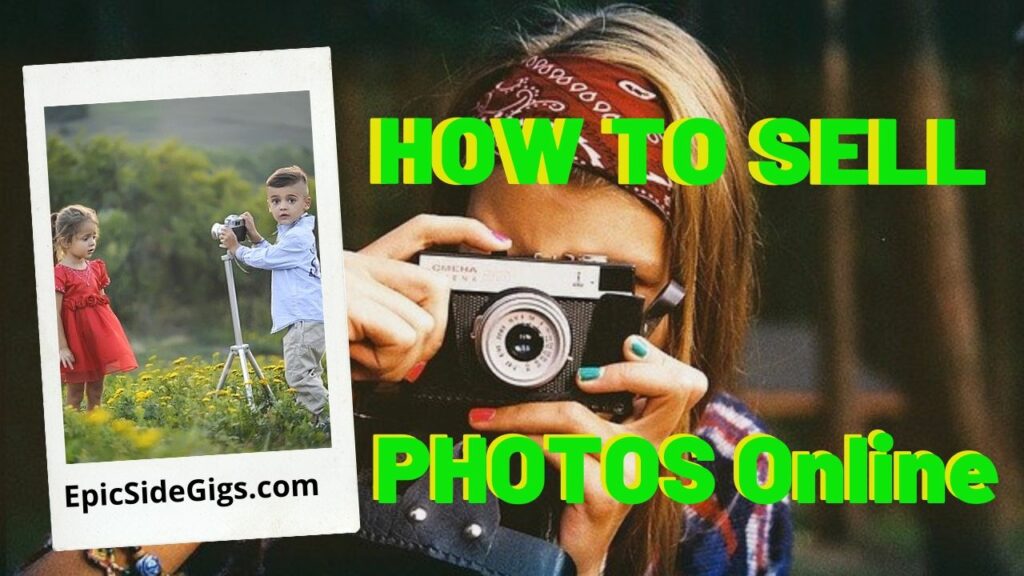
The explosive growth of the Internet has generated an equally expansive growth in Internet based commerce. The battle for attention creates an unprecedented demand for digital photo images. Why? Because a picture paints a thousand words – as the saying goes. Clearly, Web designers can convey a message more effectively by combining text with images. Text alone just does not get it done anymore. The result is a situation where the demand for digital images far exceeds the supply. Now, anyone with a digital camera – or smart phone can create a secondary income stream. How? By learning to sell photos online to stock photography sites, or marketing them yourself on your very own website.
Are you looking to make more money – or a side income?
What is Stock Photography?
Stock photography uses existing photos – already created, and makes them available for license. Users must pay a fee to both the artists that produced them and the agency that manages them. This licensing fee allows users the right to use the images legally, while the author retains the copyright of their work. (Stockphotosecrets.com)
Stock photography is an industry that creates and sells imagery in the form of photos, illustrations, or videos. These can be purchased for use through various licensing models. Customers pay a fee to buy the rights to legally use the stock photos or videos they want. They can then legally incorporate them into their marketing strategies, personal projects, or commercial applications as needed. This fee is then split between the artist that took the image and the agency that manages the sales to the public. Customers get to download the image and start using it in minutes. Photographers get to (usually) retain their copyright on the material. And agencies make a buck facilitating the transaction. (Stocksy.com)
Stock photos are images that anyone can license for creative use. Rather than hire a photographer, designers can search a large database of photos and quickly find one that works for their project. Some of the most popular stock photos include people, travel destinations, animals, and food. This system also allows photographers to earn a steady source of income from their work, in the form of small royalty payments. (Shutterstock.com)
Who Buys Stock Photos?
The largest buying base of stock photos are bloggers and small to medium sized website business owners. But, it is not just web designers that are after digital images. It is also banks, insurance companies, teachers, magazine editors, entrepreneurs, eBay sellers, scrap bookers, lawyers, realtors, illustrators, business people, affiliate marketers, online vendors, marketers, professors, students, chefs, administrators, travel agents, graphic artists, clergy, merchants, writers, advertisers, executives, retailers and the list is almost endless.
What Type of Photos Sell the Best?
The question that arises of course, is what type of pictures should a photographer take in order to generate the most sales?
Stock Photo Sites
People on stock photo sites usually buy photos of electronics, businessmen and women, money and other photos that may be beneficial to their websites or businesses. The great thing about stock photo sites is that there is no limit to the amount of photos you can upload. The more you shoot and upload the more money you will make.
Electronics Category
In the Electronics category, users are looking at things like computer monitors and keyboards, pc mice, DVD players, speakers, televisions, computer printers, car audio, cameras, mp3 players and other electronic equipment. These photos can be polished and edited using simple photo editinf software. For example, by removing the background to make them generic and therefore useable to a wider audience.
Business Category
In the business category pictures of businessmen holding money, briefcases or pictures where businessman are in communication with each other are quite popular. Be creative: take shots in various environments i.e. office shots, pictures of your subject walking, talking on the stairs outside a building and pictures of people brainstorming. You can easily slip one of your friends or family members into a business suit and have them model for you. The key requirement of course is that they look professional.
Mother Nature
There is also a massive market for good nature shots. It is important that there is an element of uniqueness and it is quite often best to edit your nature shots in some type of photo editor. Additionally photos with blank signs or pictures where your customers can easily edit or customise the pictures are also great online sellers.
Reference: Streetdirectory.com
How Much Can You Earn Online?
If your photo is unique and popular, the sky is the limit. I know of one photographer who took a picture of a mountain lake on a family camping trip. That single picture has generated over $4,000 in royalties and is still making money – you can check it out here if you like.
“This photo was taken during a family camping trip with my wife and our one year old daughter. The entire three week family vacation cost around $3,500, and it’s still hard for me to believe that this one photo ended up getting more revenue than the cost of the entire trip. As an amateur, I have never sold a photo license for anywhere near $4,000. Instead, this photo has sold over 6,000 licenses for less than a dollar each. Over the years, these Microstock license sales paid to upgrade my DSLR to a full-frame system, purchase a new a micro 4/3s system, and cover all my photography software costs.”
Source: petapixel.com
Can I Quit My Current Job to Sell Photos Online?
You probably aren’t going to get rich selling photos online, but you can earn some extra cash from your efforts. That’s always a good thing! Many studies estimate that sellers earn on average $0.25-0.45 per month for every image listed. That means if you have 100 images available for sale, you may be earning around $25-45 per month. One thousand images would generate $250-$450 per month. More images means more money.
You also make more when you sell the photos directly to consumers yourself, as you eliminate the middleman. You can even partner up with people who want you to take unique, branded photography that’s exclusive for their business. These situations pay well but aren’t passive. Selling photography can be a small side hustle you do for passive income. Or it can morph into your full-time gig. It really depends on your goals, and the type of photographs that you work with. (Theworkathomewife.com)
What is the Difference Between Microstock and Macrostock Image sites?
The short answer is that macrostock image websites sell rights to super high quality images. These image rights are normally sold exclusively or to a limited number of buyers. As the internet flourished, microstock image websites began to populate the landscape. Microstock agencies sell rights to good quality images to an unlimited number of buyers.
Macrostock Image Sites
But, in practice, it is a little bit more complicated than that.
“Let’s start with the macrostocks: Macrostock image websites generally sell you exclusive rights to images (or other media products). This means that only you have the right to use them, they are yours only. This exclusive right to an image also means that the cost will normally be high compared to an image sold at a microstock image agency. Some users need, or at least want, exclusive rights to use an image (or other media products). For instance, if an image will be used in a marketing campaign intended to reach millions of people, one would ideally want an exclusive product.
Meaning, one would not want the same image to also be used in a different marketing campaign by someone else, to appear on someone else’s website, blog, etc. This happened a few years ago when PC competitors Dell and Gateway used the same photo in their “Back to School” promotional campaigns. Needless to say, this was a big embarrassment to both PR campaigns. In addition, many website owners would not want the images they use on their website to also appear on other websites or elsewhere.”
Source: https://topimagesites.com/
Microstock Image Websites
Microstock image websites on the other hand, sell you images and other media products without giving you an exclusive right to them. In other words, these agencies can sell the same image to several users. These users then normally get what’s called a royalty-free license to the media product, or in some cases a rights-managed license. To have such non-exclusive rights to use products works well in many circumstances.
Let’s say you have a blog and you need a few images every week for your blogposts. You are probably fine if your images are also used 10 or 20 other places on the web. Or, if you have a website that needs 100 different images on various pages, you are probably also OK to use images that are used sparingly elsewhere. The big upside of non-exclusive licenses, is that they are significantly less expensive than exclusive ones. While an exclusive license can cost you $100 or more, a non-exclusive license can cost you less than $1 per image.
Reference: https://topimagesites.com/
20 Best Places to Sell Photos Online for Cash
1. 123RF
123rf is an established stock photo website with a customer base of more than 5 million people. It sells photos online in 44 countries and has great earning potential. Commission rates range from 30% to 60%.
Photos uploaded are non-exclusive and can be used elsewhere. 123rf works on a credit system where customers purchase credits, which in turn, allow them to buy photos. This is why commission rates vary. Subscription plans offer cheaper image prices, whereas customers pay more for single images. Prices are slightly more expensive than Shutterstock. This is a stock photo platform that pays contributors based on the number of downloads and purchases. (Photoblog.com)
2. 500px
500px is an online marketplace that helps you create a portfolio of your images and earn money. It is one of the best places to sell photos online. This free site boasts a “Pulse algorithm” that increases your exposure by adding your new uploads to a Discovery page. This page is viewed by thousands of visitors each day. The site also provides analytics and tracking services. With them, you can see how your images fare compared to those by your competitors. Ever wondered how many clicks your images receive? What about how you rank in comparison to your peers? 500px can help you find answers to your burning questions. Getting started on 500px is pretty simple. Just set up a free account and add your images. Then, wait and see what you turn up! Also, watch out for contests to help you earn more and gain additional exposure. (Enviragallery.com)
Five million photographers list their stock images with 500px, according to the site. You’ll receive 70% net for every license sold (standard licenses are $250), and your images may appear in big-name ad campaigns if you submit them for commercial licensing. To give 500px Prime a try, first sign up for a free account on 500px. Then submit your photos, enable your store and complete the required forms for each image (including model releases, liability releases, etc.). You’ll also have the option of selecting an exclusive or non-exclusive license for the images. You’ll earn more for an exclusive license, but that means you can’t license or sell the photo to anyone else.(thepennyhoarder.com)
3. Adobe Stock
Adobe Stock (formerly Fotolia) is a stock photo marketplace by the maker of the most popular photo editing software solutions, including Photoshop and Lightroom. This platform has been around for over 10 years and known to be the very first online marketplace to sell photos.The thing you’ll like most about Adobe Stock is their royalty share, which is higher than other online shops. Photos uploaded at Fotolia become a part of the Adobe Stock library. This means they are also available in other Adobe applications and thus reach millions of Adobe users and potential buyers.
Contributors make anywhere from 20% – 60% with Adobe Stock. And, unlike some other marketplaces, Adobe Stock does not force you to give them exclusive selling rights to your images. So, you can sell on Adobe Stock and other platforms at the same time. Given the behemoth that Adobe is, it’s likely that Adobe Stock will continue to become a prime destination for buyers and sellers of stock photography. (Enviragallery.com)
4. Alamy
Alamy is another a great platform on which to sell stock photos, because it doesn’t have any hard and fast rules. The site does not have as many buyers as Shutterstock and Adobe Stock. However, it’s still a great contender and another great option for revenue. Photographers can upload their photos to Alamy without licensing or any other copyrights issues. To date, Alamy has made $180 million in payouts to photographers. Alamy’s rates are competitive, too. The platform pays photographers 50% of each sale, which is significantly higher than some other competing platforms. Give Alamy a try! (Enviragallery.com)
Alamy is a British stock photography website, started in 1999. To date, it has over 60 million images and videos. There is a reason for this huge amount of content. It’s partly down to the 50% royalty payment on each photograph sold. This is one of the first choices for those looking to buy images and also sell photos online. (expertphotography.com)
5. Can Stock Photo
Another excellent place to sell photos online is Can Stock Photo. This platform offers relatively cheap prices for images. Contributors, however, are paid generously with a 40% retention for each image sold. Moreover, there are no submission fees or monthly costs. To submit photos, users must complete a simple application and submit 3 images. It should be noted, however, that contributors can only withdraw earnings when they have a balance of more than $50. In addition, users retain full rights to their images–they can be freely redistributed to other platforms. Can Stock Photo has just under 1 million active members, and boasts an easy-to-use platform and submission system. (Photoblog.com)
More than 70,000 photographers sell photos on Can Stock Photo. There are various payout structures ranging from percentages to fixed amounts. They have a referral program that pays you $5 for every 50 photos your referral sells. When you sell photos on Can Stock Photo, they also list your photos for sale on Fotosearch, a stock photography agency. (Shopify.my)
6. Crestock
Crestock can be a more passive way to earn money for your photography. Simply set up a free account on Crestock and upload your photos. Once the Crestock team evaluates your images, they’ll add them to you Crestock portfolio so that customers can purchase them.
You can, and should, add keywords and descriptions for each image. This does two things. It increases your opportunity for approval by Crestock editors. Also, those keywords and descriptions make your photos easier to find. Let’s face it, there are a plethora of stock images scattered throughout the internet.
Crestock pays contributors 20–40% commission rates based on the total number of downloads. They also have several affiliate programs through which you can earn money.
7. DreamsTime
Dreamstime is a stock photo site with a generous payout for contributors. However, they require more commitment. You must have at least 70% of your portfolio on their site for at least six months. But, non-exclusive contributors earn 25–50%, and exclusive photos generate a 27.5–55% commission. There are also lots of ways to earn money for referrals, both on the contributor and the purchaser side. (Shopify.my)
In the stock photography world, Dreamstime is a reputable player. It achieved this status by ensuring that all uploads are reviewed to check they meet their high standards, thereby guaranteeing quality. Once your photos are approved, you’ll receive royalties of 25-50 percent. However, this could increase to 60 percent on all images if you sign an exclusivity contract. If you do sign that exclusivity deal, you’ll also receive an additional bonus of $0.20 for your first 100 approved submissions. (Makeuseof.com)
8. EyeEm
EyeEm is a creative community app that lets you upload and sell photography online. Yet, it allows you to retain your own copyrights. Better yet, you’ll earn 50 percent in royalties every time someone buys one of your photos. This site pairs up with other image marketplaces as well, giving your pictures a ton of exposure. The more exposure, the more money you can earn. If you’re starting to run dry on ideas, visit EyeEm’s community page. This feature may help you to gain some inspiration from other professional photographers. (Makeuseof.com)
If you are a photographer who is focused on advertising and commercial work, EyeEm might be the option for you. You’ll find three different licenses you can sell you images under; Social, Web and Full. These images are sold to clients for $20, $50 and $250 respectively. You will need to pay 50% commission on each image sold. But without them, you might not sell any images at all. Something is better than nothing. to help get your name and brand out there, there is an EyeEm magazine, and missions that you can enter, following a specific brief. (Expertphotography.com)
9. FineArtAmerica
FineArtAmerica is the perfect place to set up an alluring portfolio, and to sell physical prints of your shots. You can sell each photo as a canvas print, poster, framed print, metal print, acrylic print, greeting card, phone case, and more. When you make a sale, the order (including the printing) can be fulfilled by the company’s own printing service. You’ll have to pay the base price for the production, but you can make a profit by raising the price of the final product. In other words, if a canvas print costs $50 for FineArtAmerica to produce, you can increase the price to $75—that way, you’ll earn $25 from an order. (Makeuseof.com)
10. Foap
Foap featurs itself as being a profitable app for photo selling. Users make 50% of the profits from Foap. Big brands – like Sony and MasterCard buy photos from the site. The way that Foap works is quite novel compared to regular stock photography websites. Foap targets customized visual-content submitted by creative professionals. As mentioned above, Foap really isn’t a regular stock photography website.
A brand looking for the perfect photo would turn to Foap and send them a brief description of what they want. The brief includes details, like the tone, aesthetics, subject and target audience. Photographers then compete in what Foap interestingly calls Missions. Submitting a photo or video to one of Foap’s missions is the easiest way to make the most money out of selling your creative work. All you need to do is produce a photo that matches the described Mission brief . Your objective is clear. Satisfy the requirements and deliver the kind of imagery that the brand is looking for. With Missions, just one photo has the potential to make hundreds of dollars.
11. Getty Images
Getty Images is on the higher end of stock photography sites. They attracts brand and publishers looking for high-quality or hard-to-find exclusive images to license. The standards for becoming a contributor are predictably higher than many other stock photo sites. For photos licensed via GettyImages.com, rates start at 20%. (shopify.my)
Often seen as the top dog of stock photography, Getty Images boasts unbelievable quality images and has an impressive range of clients. You’ll often see Getty Images used in news articles. The best thing about them is the photo sale price is fantastic, even for small resolution images. So even though the commission is only 20%, you can still make a decent amount. However, images are exclusive, so you cannot sell images anywhere else if they have been uploaded to Getty Images. Another plus is that the approval process for photos is considered more lenient than some other sites. They may, for example, accept a photo if it shows exceptional artistic qualities, even if part of it is out of focus. (Photoblog.com)
12. GuruShots
GuruShots isn’t exactly a place where you can sell photos online. Nevertheless, you can still use them to make money with your photos. Similar to a photo competitions, photographers compete against each other. There are a large number of themes and different subjects from which you can choose. Other photographers then vote on the images and the winners get prizes worth up to $300. To enter a challenge, you can upload up to four images for that theme. According to their site,
“GuruShots uses special proprietary algorithms to make sure each submitted photo gains equal exposure regardless of when it was submitted during the challenge, giving each entrant an equal opportunity to win through ‘statistically based objectivity’.”
13. iStock Photo
iStock photo is a great place to sell stock photos if you are just starting out. They have popular forums and resources, helping you understand how to upload and sell photos online. Getty Images owns this service. This is a stock photography page. Their iStock service is a microstock service. The royalty payment starts at 15% per download. It can increase to 45%, depending on your photos’ popularity. If a customer purchases an image using their subscription credits, you only receive the 15%. If you are into exclusivity, iStock photo will give you between 22-45%. This works on a contract with a 30 days notice period. (Expertphotography.com)
14. PhotoShelter
PhotoShelter is an online shop to sell and deliver prints to the clients. They allow you to set up your template for sharing the photos. However, you need to buy the space on their platform to upload the photos. There are multiple plans for monthly and yearly options with different features. (Enviragallery.com)
At its core, it’s a photography-oriented eCommerce platform that you can integrate into almost any website. This includes cloud storage for your photos, a built-in shopping cart, drag-and-drop website templates, an intuitive interface, decent SEO (search engine optimization), and several social media integrations. The benefits of this option include retaining full control over how your photos are displayed, not having your competitors photos displayed alongside your own, and the ability to earn much more of the sale price. (Makeuseof.com)
15. Shutterstock
Shutterstock is a micro-stock site where photos are cheaper and non-exclusive. The way to increase downloads is by contributing a large quantity of images that can be used as visual metaphors. Don’t expect to earn as much here, but it’s a good place if you’re just starting out. Payouts are based on your earnings over time and range from 20% to 30%. There’s also an affiliate program where you can earn additional money if you refer new photographers or customers. https://www.shopify.my/
However, you can still earn up to $120 per image download on Shutterstock. This site has a fairly complicated pricing structure, but the more you earn (“lifetime earnings”), the more you take home for each image. In total, contributors have earned a total of more than $300 million from over 500 million downloads. People definitely snap up these images. Shutterstock also sells stock video footage, including HD and 4K videos, as well as images and vectors. You can also refer other photographers and make a small profit, typically around four cents, each time they sell an image. If you refer a customer who purchases images, you can earn 20% of their first purchase, up to $200. (thepennyhoarder.com)
16. SmugMug
Smugmug is a great site for those photographers with an entrepreneurial mindset. They let you choose how much to charge for your images, and they let you keep 85% of the markup. Here’s an example for that from their website: “If you sell a 5×7 for $10.79 and the SmugMug default price for it is $0.79. The markup is $10.00. You keep $8.50 as profit (85% of $10)”. The catch here is you have to buy a Pro subscription. This starts at $12.50 per month. There is no free option to take advantage of. (Expertphotography.com)
17. Stocksy
If you are accepted by Stocksy, you could earn a lot. This curated stock photo site periodically opens applications. You cannot join at any time, like other stock sites. The emphasis here is on quality and the photos featured are exceptional. If you are accepted, you know that you have true talent. It has a fantastic 50% standard earning rate; one of the best available for stock photo sites. Contributors must remember, however, that exclusivity of your images is required. The platform is fantastic though and has a large customer base with decent base prices for photos. Photoblog.com
Stocksy pays out some of the highest royalties for contributors, making it one of the best sites to sell photos online. To apply, you’ll need to submit at least 25 photos, along with some information about yourself. If you manage to get accepted, expect to see royalties ranging from 50-75 percent. Stocksy recruits top-notch photographers who take high-resolution images. You should also keep in mind that Stocksy requires that all of your photos are exclusive. (makeuseof.com)
18. Snapped4u
Snapped4u makes selling your event photos a piece of cake. If you shoot weddings, parties, engagements or other events, Snapped4u was designed to make your life easier and your pocket thicker. With Snapped4u, you can make a gallery and upload images from an even you shot to that gallery. Then, you set the price of the photos and… that’s all! From there, Snapped4u sells your images as jpeg files and emails them immediately to you buyers. Then, Snapped4u sends you the money you made via PayPal on the first of each month.
Because each Snapped4u seller has her own gallery page, customers who book you for multiple events can always find your images in the same place. And, you can give your personalized URL to anyone you think might want to purchase your photos. Snapped4u gives you the biggest profit share on each sale. If the photos are sold on good prices, then Snapped4u will charge a commission. (Enviragallery.com)
19. TourPhotos
TourPhotos is a hub for tourists and travel photographers across the globe. In fact, many travel agencies and tour companies use it to upload photos of their adventure trips for attendees and general public to purchase. It is a great platform for travel photographers to sell their photos online to a like-minded audience. And, you’ll likely feel inspired by all of the beautiful photography that winds up on TourPhotos! (Enviragallery.com)
20. Twenty20
Twenty20 started as a tool for Instagram photographers to sell their images to brands. Now, it’s a robust stock photography site where you can sell photos online and connect with potential clients. You can earn money three ways: selling a photo, for you earn $2 per photo licensed, $100 cash prizes from photo challenges, and 100% commission from whatever brands hire you for scheduled shoots. (Shopify.my)
Conclusion
The easiest way to make your photographs available as stock images for sale is by using a third-party microstock website such as any of those listed above. Selling your photos through a stock agency like this is quick and easy. They do all the marketing for you and thousands of people search for images on these sites every day. Many photographers get started selling stock photography by listing their images on sites like these. Stock photography sites are great in two ways.
- They sell your work for you – You upload the image and sit back while they do the work.
- Information source on current trends – This means they give you ideas and hints on what images have a higher chance of making you money.
However, there are drawbacks to this approach
- Commissions – You’ll be paying a large commission on each sale for every image that you sell. These fees vary quite a lot between different sites and depending on the restrictions of the licenses you offer. Most sites offer between 20% and 60% royalty to the photographer per sale.
- Controlled Price Structure – The set price for stock images also varies widely between sites. Some sites sell images for a little as a dollar per image for low-res photographs, leaving you with pennies after the site has taken their commission. Other sites charge more for images but sell at lower volumes so it’s worth experimenting with a few different sites to see what suits you best.
- Competition – Another point to consider is that most stock image sites make it very easy for people to pick and choose images from many different photographers and won’t do much to help you to grow your brand. Ideally you want people browsing stock to choose from your portfolio before they start looking anywhere else.
https://graphpaperpress.com/
Are you looking to make more money – or a side income?



